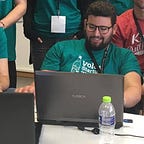NestJS - Getting Started
2 min readJan 27, 2024
In this section, we’ll create a new NestJS project and execute some basic setup steps to start the development.
This section is part of a larger guide.
Install NodeJS using Node Version Manager.
# Install NVM
curl -o- https://raw.githubusercontent.com/nvm-sh/nvm/v0.39.2/install.sh | bash # install latest nodejs version
nvm install node # alternatively nvm install <your-desired-node-version>
Project initialization
# First of all we need to install NestJS CLI
npm i -g @nestjs/cli# Generate the NestJS repository
nest new nestjs-app # you can select your desired application name
cd nestjs-app # navigate to your app’s root directory# Save your current node version for future usage
node -v > .nvmrc # saves current nodejs version
nvm use # loads and uses saved nodejs version
Now you have a fully operational NestJS project so you can start the development. You can verify that everything went well by running your default application:
npm run start # development
npm run start:dev # watch mode
npm run start:prod # production modeOr test your code
npm run test # unit tests
npm run test:e2e # e2e tests
npm run test:cov # test coverageOr fix its quality:
npm run format && npm run lintNow that everything is set up we can start the development. But before that let’s showcase some of the NestJS basics.
